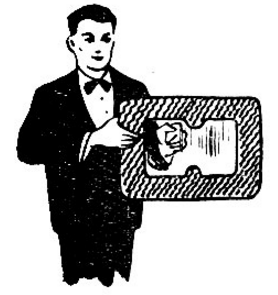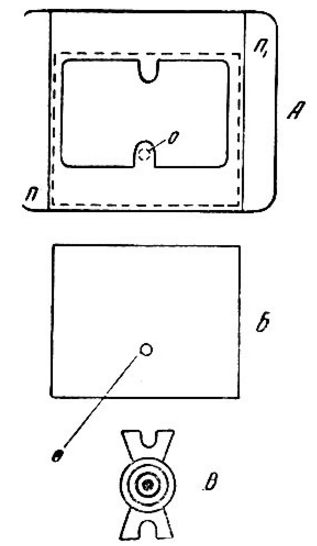
|
|
EFFECTIVE FOCUSES AND THEIR CLUES Glass piercing. Focus secret
Directory / Spectacular tricks and their clues Focus Description: The magician takes out a frame with glass inserted into it. Passing among the audience, he taps on the glass (Fig. 95), thus proving that the glass is intact. Returning to the stage, he gives his assistant to hold the glass, and he puts the target into the frame.
The assistant gives a large steel needle, which the performer shows to the audience. Having inserted a tape into the eye of the needle and approaching the target, quickly and accurately pierces the target to the center, and then immediately pulls the needle (Fig. 96) and the entire tape through the target and glass. After that, taking the glass from the assistant, he pierces it with the index finger of his right hand and shows it to the audience.
Taking his finger out of the glass, he tears off the target, and the glass turns out to be intact. Tapping on the glass with his right hand, the performer shows the audience that the glass is intact. Props: Glass in a frame painted on all sides. Two cardboard targets. Metal needle 35 cm long and 1 cm thick. Silk ribbon about 2 m long and 4-5 cm wide. Focus secret: The secret of this number is in the device frame and glass. It is good to use plexiglass (organic glass) with a thickness of 2 mm for this purpose. Ordinary glass is also suitable, but it is fragile, and it is more difficult to drill a hole in it. On fig. 111 the letter A denotes one half of the frame with the glass lying on it (the latter is marked by a dotted line). The glass can slide freely inside the frame. The top half of the frame has been removed for clarity. The frame inside is pasted over with strips of thin velvet tape so that the glass can move freely between the walls of the frame P and P1 up and down, as shown in the figure.
In glass, which is shown separately in Fig. 111, B, a hole O is made in such a way that, when lowered, it would not be visible behind the protruding ledges in the frame. These protrusions make it possible to make the frame narrower and to fix the targets 5, which are fixed by the collar of the latch. Now, if we turn the glass "upside down", then the hole O will take place in the center of the frame. Spectators cannot see it, as we put targets on both sides. Now the whole secret of this trick is clear. It is easy to calculate the size of the frame yourself, according to your taste and desire. Before cutting the glass, we advise you to cut out a template from cardboard and, having made a hole in it, check it in the frame. If the hole hides behind a ledge and becomes exactly in the center when turned over, this means that the template is made correctly and glass can be cut from it. Hole O should be made according to the thickness of the needle so that the tape passes freely. Having made the glass and adjusted it, the second (upper) half of the frame is applied and all this is glued together. When the frame is turned over, the glass should slide freely and stop without knocking - the velvet tape will soften the stroke and impacts. When your frame with glass is completely ready, it is very good to paste over it with canvas, prime it and paint it with oil varnish paints. The pattern should be chosen so that the audience, when turning the frame over, could not notice it. Mosaic works well in this case. Having started the number, the glass is shown to the audience when it is lowered down and the hole O (see Fig. 111, A) is hidden behind the ledge of the frame. Then, putting on the target (see Fig. 111,5), at a convenient moment they turn the frame over, and the glass goes down, and the hole O is in the center of the frame. After the glass is pierced, the back target is removed and at the same time the frame with the second target is discreetly turned over, holding it in front of you. Spectators will not notice how the glass, turning over, will fall down and hole O will again disappear behind the ledge of the frame. Lightly holding the glass with your fingers, show it to the audience, while you can lightly tap the glass with your hand. Sometimes they make a stopper with a button on the side of the frame. This stopper allows you to hold the glass in any position and lower it at the right time. But in order not to complicate the design, it is better to do without a stopper. With good practice, you can easily and completely imperceptibly hold the glass with your fingers. Keep the frame in a closed case. This is necessary to protect against dust, which, settling on the glass, scratches it; because of this, stripes from the movement of glass in the frame become noticeable. The trick described by us is demonstrated in circuses, and it is shown both as recommended here, and in a complicated version, as an illusion: by increasing the size of the glass and frame, they make such a hole so that a midget can freely climb into it. Instead of a target, black velvet doors are placed on both sides, through which the midget crawls. These shutters hide a hole in the glass. The frame is fixed on a solid stand in which it can turn over freely. Author: Vadimov A.A.
Air trap for insects
01.05.2024 The threat of space debris to the Earth's magnetic field
01.05.2024 Solidification of bulk substances
30.04.2024
▪ Restarting the Large Hadron Collider ▪ Efficient vertical solar systems for parking lots ▪ Flexible thermoelectric generator for powering wearable devices
▪ section of the site Microcontrollers. Article selection ▪ article by Theodor Adorno. Famous aphorisms ▪ article What are genes? Detailed answer ▪ article Zubrovka South. Legends, cultivation, methods of application ▪ article Pump control scheme. Encyclopedia of radio electronics and electrical engineering
Home page | Library | Articles | Website map | Site Reviews www.diagram.com.ua |






 Arabic
Arabic Bengali
Bengali Chinese
Chinese English
English French
French German
German Hebrew
Hebrew Hindi
Hindi Italian
Italian Japanese
Japanese Korean
Korean Malay
Malay Polish
Polish Portuguese
Portuguese Spanish
Spanish Turkish
Turkish Ukrainian
Ukrainian Vietnamese
Vietnamese




 See other articles Section
See other articles Section 